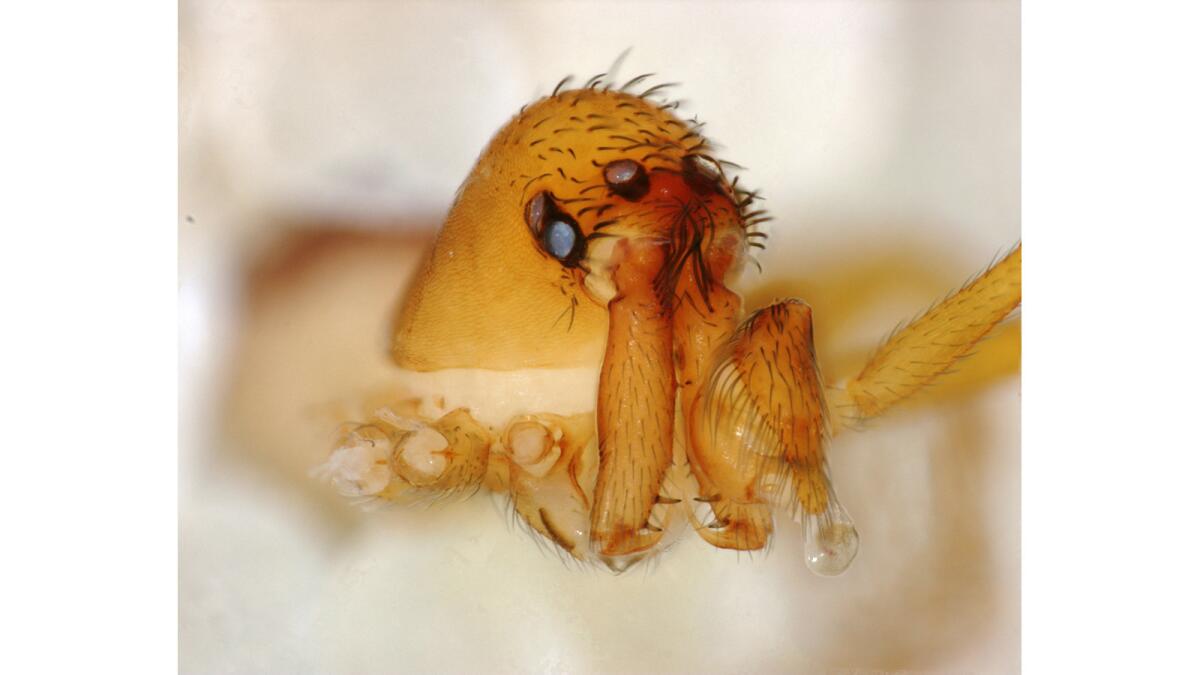Watch trap-jaw spiders chomp their prey at lightning speeds

- Share via
A tiny spider lies in wait for its prey to approach, jaws agape. When the insect gets within striking range ... Snap! The hunter’s jaws clamp shut around the unsuspecting victim, all in a fraction of a second.
While most spiders catch prey by building webs, trap-jaw spiders, a family of ground-dwelling arachnids found only in New Zealand and the southern third of South America, rely on their hunting prowess to nab a bug to eat.
To do this, the diminutive spiders had to evolve high-powered jaws and the ability to close them at incredible speeds, according to a new study in Current Biology.
Hannah Wood, now an entomologist at the Smithsonian Institution’s National Museum of Natural History, filmed 14 different species of trap-jaw spider under a high-speed camera as a doctoral student at UC Berkeley. Using an eyelash glued to a pin (the spiders are that small), Wood prodded the spiders into a strike to test their reflexes.
The resulting videos showed stunning differences in the speeds at which the spiders moved. Some were so fast that they had to be recorded at 40,000 frames per second (the slowest ones were recorded at only 1,000 frames per second).
The fastest trap-jaw spider was Zearchaea sp4, a species from New Zealand that’s yet to be formally named and described, which snaps its jaws shut at 8.5 meters (28 feet) per second -- that’s 100 times faster than the slowest species measured.
The study found four of the spiders were producing movements that were faster than their tiny spider muscles could produce on their own.
“When you’re a really small organism it’s hard to have quick, strong movements,” said Wood said.
But trap-jaw spiders, which range in length from 2 to 10 millimeters, or less than half an inch, seem to have both traits. Therefore, their powers must come from some ability to store the energy needed to produce their super-quick strikes, Wood thought.
The study suggests the trap-jaw spiders possess an unusual anatomy compared with most other arachnids. Three-dimensional visualizations based on micro-CT scans reveal they have elongated jaws with horizontally oriented muscles, which allow them to open up their chops to extreme angles.
It’s possible these structures help to amplify the power of the spiders’ strikes, although the exact mechanisms remain unknown, Wood said. By slowly stretching the muscles and suddenly releasing them, the jaws can snap closed like a rubber band.
Using DNA analysis, Wood and colleagues found this ability evolved at least four times in the trap-jaw spider, or Mecysmaucheniid, family. The behavior has been observed before in ants, but never in arachnids, the authors wrote.
Their unusual anatomy “allowed them to do things that they couldn’t do previously,” Wood said. “They’re evolving from the same base plan. They’re evolving this innovative trait that sort of sets the stage for this diversification to happen.”
With about 25 described species of trap-jaw spider, and up to 30 additional species waiting to be described by science, Wood said exciting discoveries can still be made by looking at under-studied creatures.
“There’s so little we know about spiders that someone can go into the field and observe these bizarre behaviors for the first time,” Wood said.
Follow me on Twitter @seangreene89 and “like” Los Angeles Times Science & Health on Facebook.
ALSO
Scientists say the ‘R’ in RNA may be abundant in space
In Portugal, white storks ‘addicted’ to junk food don’t bother to migrate
Myth busted: Vipers aren’t the fastest snake in the world. Others are just as fast




